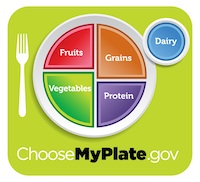To get Americans to eat healthier, the U.S. Department of Agriculture wants them to think about their dinner plates -- literally.
The department recently unveiled its MyPlate campaign, which uses a plate instead of the old pyramid to illustrate a balanced meal. The plate is divided with labeled sections to show proper portions for fruit, vegetables, grains and meat on the plate, and includes a small blue circle to its side to show dairy as the drink.
“This new symbol is the beginning of the conversation. It is the image that gets people talking about what they eat and shows the variety of foods people should be consuming and the proper proportions that should be consumed from each food group,” said Connie Crawley, a nutrition specialist with University of Georgia Cooperative Extension. “People don’t eat on a pyramid, they eat on a plate. This presentation is easier for people to understand.”
For example, the plate’s vegetable section is larger than its fruit section, which shows that a person needs to eat more vegetables than fruits each day, she said.
The guidelines focus on balancing calories with physical activity and encourage Americans to eat more vegetables, fruits, whole grains and low-fat dairy products and less sodium, saturated fats, trans fats, added sugar and refined grain.
The guidelines' core messages are to:
- Enjoy food, but eat less.
- Avoid oversized portions.
- Fill half your plate with fruits and vegetables.
- Drink fat-free or low-fat milk.
- Compare sodium levels in foods and choose foods with lower sodium.
- Drink water instead of sugary drinks.
“The fresher the food the better,” Crawley said. “Or the least processed the better.”
Buy frozen fruits and vegetables instead of canned. But even frozen entrees labeled as “healthy” are still high in sodium and often have “a long list of mystery ingredients,” she said.
While some frozen meals are good for portion control, adding a fresh fruit or one vegetable and a glass of milk will balance out the meal.
Many children consume most of their daily calories from sugar or fat. “They are eating a very energy-dense diet that is low in nutrients like vitamins and minerals,” Crawley said.
New school regulations will limit sugary drinks and trans fat foods in schools. “It is much easier to train a kid to choose more nutritious foods than to change an adult later,” Crawley said. “If the whole family adopts healthy eating habits, they will all benefit.”
The USDA recommends children and adolescents have at least one hour of physical activity daily. However, less than half of children and only 8 percent of adolescents get this much exercise. Adults should be active at least 150 minutes a week to prevent and control chronic disease, but only five percent actually are.
“It is important to encourage young people and adults to participate in physical activities that are appropriate for their age, that are enjoyable and that offer variety,” Crawley said.
Educational tools about the new MyPlate recommendations are available from the USDA at www.choosemyplate.gov.







